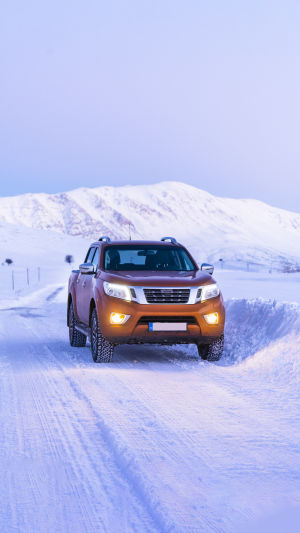As winter approaches, snow driving becomes a challenge for many drivers.
Snow and frost not only reduce road friction, but they may also cause visual obstruction and increase driving risks.
To ensure a safe trip, here are six essential tips to help you drive more safely in the snow.
<h3>1. Clean the Snow Off the Car Roof</h3>
One of the most critical safety measures before driving in the snow is thoroughly cleaning the snow off your car roof. When the heater inside the car is turned on, the temperature difference can cause the snow to detach from the roof.
Similarly, driving on bumpy roads can dislodge the snow. If you brake suddenly, the snow from the roof can slide down onto your windshield, obstructing your view instantly.
<h3>2. If the Handbrake is Frozen, Do Not Use Hot Water on the Brake Disc</h3>
In snowy conditions, it's common for the handbrake to freeze. If you release the handbrake, the brake end might remain engaged, preventing the vehicle from moving.
Many people mistakenly pour hot water on the brake discs, thinking they are frozen. However, this doesn't help because the issue is the handbrake cable.
Water splashed up while driving can seep into the handbrake cable housing and freeze. Therefore, you should pour hot water on the handbrake cable instead of thawing it out.
<h3>3. Release the Brakes When Losing Steering Control</h3>
A car can lose its steering ability if the front wheels lock up. This is basic knowledge that every qualified driver should know, yet many drivers remain unaware. Although most cars today have ABS (Anti-lock Braking System), ABS does not function effectively at very low speeds.
Often, you see cars losing control after the wheels lock up on snowy roads at low speeds, causing the vehicle to slide uncontrollably. In such cases, you should release the brakes to allow the front wheels to start rolling again, which will immediately restore steering control.
<h3>4. How to Quickly Clear Windshield Ice</h3>
If it snows overnight and the temperature is very low, your windshield may be covered with snow on top and ice underneath, making it difficult to clean.
A practical solution is to fill a plastic bag with hot water and roll it back and forth inside the windshield. While this won't melt all the ice, it will loosen the bond between the ice and the windshield, allowing you to easily remove large chunks of ice and snow with a snow shovel.
<h3>5. Avoid Wheel Slip on Sloped Snowy Roads</h3>
When driving on a snowy slope, it's crucial to prevent the wheels from slipping. If the car remains stationary without sliding, it shouldn't slide when reversing, provided the slope doesn't get steeper.
The key is to avoid wheel slip, as maintaining static friction between the wheels and the ground will ensure you can reverse slowly without slipping. Once the wheels start slipping, static friction is lost, causing the wheels to slide in the direction of least resistance.
<h3>6. Understanding Poor Windshield Defogging Performance</h3>
Modern cars often have a one-touch defogging button on the automatic air conditioner. This feature is highly effective in winter, but many people find it less effective after it snows.
The issue may lie in the air intake for the external circulation of warm air located between the windshield and the engine cover. If this area is covered with snow, the air intake is blocked, reducing the output of warm air and the effectiveness of the defogger.
To resolve this, clear the snow from the intake area or manually switch the heater to internal circulation, as the one-touch defogger mode does not allow manual control of the circulation settings.
<h3>Conclusion</h3>
Driving in the snow is not only a test of driving skills but also a challenge to safety awareness. These six essential tips provide practical guidance to help you drive more safely this winter. Wishing you a safe journey and a safe return.





